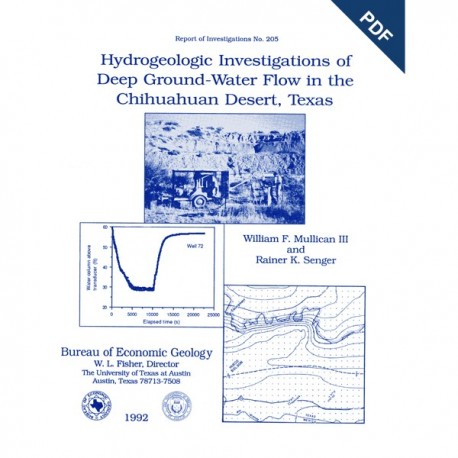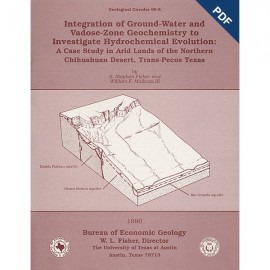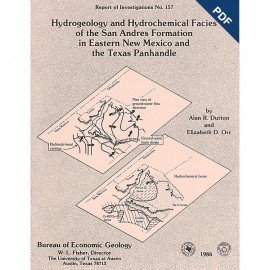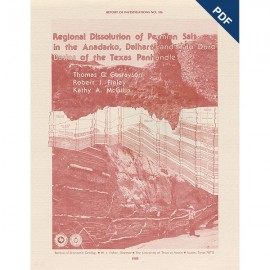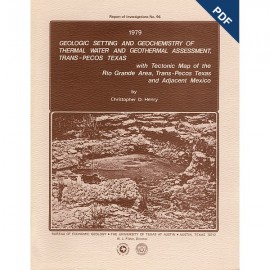Reports of Investigations
-
Books & Reports
- Reports of Investigations
- Guidebooks
- Udden Series
- Geological Circulars
- Down To Earth
- Atlases of Major Oil and Gas Reservoirs
- Texas Memorial Museum Publications
- Environmental Geologic Atlas of the Texas Coastal Zone
- Mineral Resource Circulars
- Other Reports
- Seminars and Workshops
- Handbooks
- Submerged Lands of Texas
- Symposia
- Annual Reports
- Open File Reports
-
Maps & Cross Sections
- Thematic Maps
- Miscellaneous Maps, Charts & Sections
- Geologic Atlas of Texas
- STATEMAP Project Maps
- Geologic Quadrangle Maps
- Cross Sections
- Highway Geology Map
- Energy and Mineral Resource Maps
- Shoreline Change and Other Posters
- Wilcox Group, East Texas, Geological / Hydrological Folios
- Bouguer Gravity Atlas of Texas
- River Basin Regional Studies
- Featured Maps
- Posters
- Teachers & the Public
-
Geological Society Publications
- Gulf Coast Association of Geological Societies
- Alabama Geological Society
- Austin Geological Society
- Corpus Christi Geological Society
- Houston Geological Society
- Lafayette Geological Society
- Mississippi Geological Society
- New Orleans Geological Society
- South Texas Geological Society
- GCS SEPM Publications
- Historic BEG & UT Series
Hydrologic Investigations of Deep Ground-Water Flow in the Chihuahuan Desert, Texas. Digital Download
RI0205D
For a print version: RI0205.
RI0205D. Hydrologic Investigations of Deep Ground-Water Flow in the Chihuahuan Desert, Texas, by W. F. Mullican III and R. K. Senger. 60 p., 28 figs., 4 tables, 1992. doi.org/10.23867/RI0205D. Downloadable PDF.
To purchase this publication in book format, please order RI0205.
ABSTRACT
Regional and local hydrologic investigations were conducted in Trans-Pecos Texas as part of a study to evaluate potential sites for a low-level radioactive waste repository. The area is approximately 40 mi (65 km) southeast of El Paso in the Hueco Bolson, a fault-bounded desert basin that developed in the late Tertiary. Ground water in the principal study area is found in Hueco Bolson silts and sands at depths of 361 ft (110 m) and 478 ft (146 m), and at depths of 592 ft (180 m) in Cretaceous limestones. The unsaturated zone consists of approximately 50 ft (15 m) of alluvial silt, sand, and gravel underlain by 300 to 500 ft (91 to 152 m) of lacustrine and fluvial clay, silt, and fine sand. The scope of this investigation included (1) evaluating groundwater resources in the area, (2) determining ground-water flow paths and velocities, and (3) testing hydrologic hypotheses using ground-water flow models.
Development of ground-water resources in the vicinity of the principal study area is limited by (1) costs of drilling and completing wells and of producing water at depths typically greater than 400 ft (122 m) and (2) extremely low aquifer productivity. Transmissivities of aquifers in bolson and Cretaceous strata, as revealed by 12 aquifer tests, range from approximately 0.19 to 290.0 ft2/d (0.018 to 26.9 m2/d); corresponding permeabilities range from 0.0015 to 2.82 ft/d (0.0005 to 0.861 m/d). A composite potentiometric surface based on water levels measured in available wells, assuming hydrologic interconnection of the Diablo Plateau aquifer, Hueco Bolson silt and sand aquifer, and Rio Grande alluvium aquifer, indicates that ground water is recharged on the Diablo Plateau and flows to the south and southwest toward the Rio Grande beneath the bolson pediment. Little, if any, groundwater recharge occurs through the bolson surficial sediments, because of a high degree of precipitation runoff and extremely high evapotranspiration rates. A planar ground-water flow model was constructed to investigate the dominant controls on the regional flow pattern. The inferred distribution of permeability zones focuses flow from the Diablo Plateau in the eastern part of the study area toward Cretaceous outcrops in the footwall of the Campo Grande fault, creating a ridge in the potentiometric surface. The relatively low hydraulic heads reflected in the valley in the potentiometric surface near the principal study area are caused by preferential drainage along relatively permeable bolson deposits to the west and southwest toward the Rio Grande. Water-chemistry data, particularly data on tritium, carbon-14, and total dissolved solids, generally support the interpreted flow pattern; some discrepancies can be related to paleohydrologic effects associated with the incision of the Rio Grande during Quaternary time.
Keywords: aquifer characteristics, aquifer test, Chihuahuan Desert, ground water, ground-water resources, Hueco Bolson, paleohydrology, Texas, Diablo Plateau
CONTENTS
Abstract
Introduction
Hydrogeologic Setting
Previous Regional Hydrologic Investigations
Methods
Aquifer Test Results
Well 22 Aquifer Tests
Wells 72 and 73 Aquifer Tests
Well 91 Aquifer Test
Well 94 Aquifer Test
Well 98 Aquifer Tests
Aquifer Test 6
Aquifer Test 7
Well 99 Aquifer Test
Well 107 Aquifer Test
Well 126 Aquifer Test
Summary of Hydraulic Properties
Evaluation of Ground-Water Resources, Hudspeth County
Water Water Supply
Hydraulic-Head Distribution
Modeling of Regional Ground-Water Flow
Conceptual Model of Ground-Water Flow
Boundary conditions
Delineation of permeability zones
Diablo Plateau aquifer
Hueco Bolson silt and sand aquifer
Rio Grande alluvial aquifer
Additional permeability zones
Discussion of Simulation Results
Relationship between Ground-Water Flow and Water Chemistry
Implication to Paleohydrologic Conditions in the Hueco Bolson
Conclusions
Acknowledgments
References
FIGURES
1. Location of water wells and one spring within the regional hydrologic study area
2. Hydrologlc cross section A-A’ illustrating general geometry of hydrostratigraphic units relationship between potentiometric surface and stratigraphy from the Diablo Plateau to the Rio Grande
3. Geologic and hydrologic units in the regional study area
4. Fluctuations in water levels of wells in study area
5. Schematic diagrams of well 22 during aquifer test and well 22* after recompletion
6. Hydrologlc plots of data from aquifer test conducted in well 22, October 5-6. 1988
7. Hydrologlc piots of data from aquifer test conducted in well 22*. October 10-13, 1989
8. Schematic diagram of wells 72 and 73 during aquifer tests conducted in November and December 1989
9. Hydrologlc plots of data from aquifer test conducted in well 73, November 26 to December 18, 1989
10. Discharge rates for aquifer test conducted in well 73, April 11 to May10, 1990
11. Hydrologic plots of data from aquifer test conducted in well 72, April 11 to May 10, 1990
12. Hydrologic plots of data from aquifer test conducted in well 73, April 11 to May 10, 1990
13. Hydrologlc plots of data from aquifer test conducted in well 72. October 10, 1990
14. Hydrologic plots of data from aquifer test conducted in well 91, April 28, 1989
15. Hydrologic plots of data from aquifer test conducted in well 94, October 1-3, 1989
16. Schematic diagram of well 98 during aquifer tests conducted in May and September 1989
17. Hydrologlc plots of data from aquifer test conducted in well 98, May 30-31, 1989
18. Hydrologlc plots of data from aquifer test conducted in well 98*,September 14-15, 1989
19. Hydrologtc plots of data from aquifer test conducted in well 99, November 9-12, 1988
20. Hydrologlc plots of data from aquifer test conducted in well 107, September 30, 1989
21. Schematic drawing of well 126 during slug test
22. Hydrologlc plots of data from aquifer test conducted in well 126, September 13, 1989
23. Photographs of dirt tank located west of study area taken immediately before and after rainfall event in July 1988
24. Potentiometric surface map of regional hydrologic study area
25. Distribution of total dissolved solids and tritium concentrations of water samples collected at wells in the area
26. Delineation of permeability zones in the model area that are incorporated in the planar ground-water flow model
27. Distribution of simulated hydraulic heads for simulation S-34
28. Streamlines and fluxes calculated for each element on the basis of simulation S-34
TABLES
1. Summary of pumping-test results iil bolson deposits
2a. Transmissivity results of aquifer test analyses for wells evaluated during study
2b. Permeability results of aquifer test analyses for wells evaluated during study
2c. Transmissivity and permeability results of aquifer (slug) test analyses for wells evaluated during study
2d. Dates and hydrologic conditions during aquifer tests
3. Water wells within 10 mi of principal study area
4. Transmissivities assigned to permeability zones in the model
Citation
Mullican, W. F., III, and Senger, R. K., 1992, Hydrologic Investigations of Deep Ground-Water Flow in the Chihuahuan Desert, Texas: The University of Texas at Austin, Bureau of Economic Geology, Report of Investigations No. 205, 60 p.
